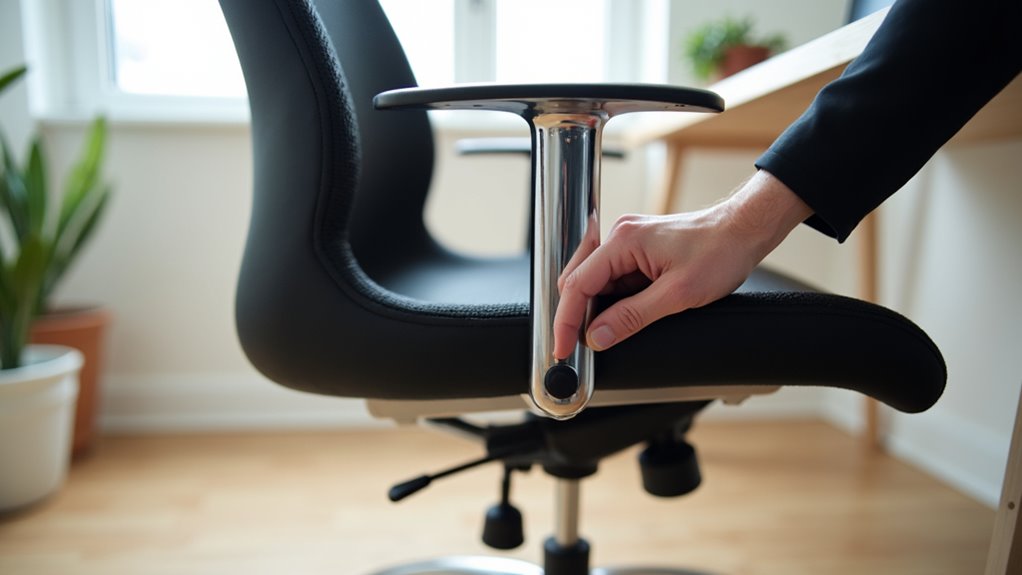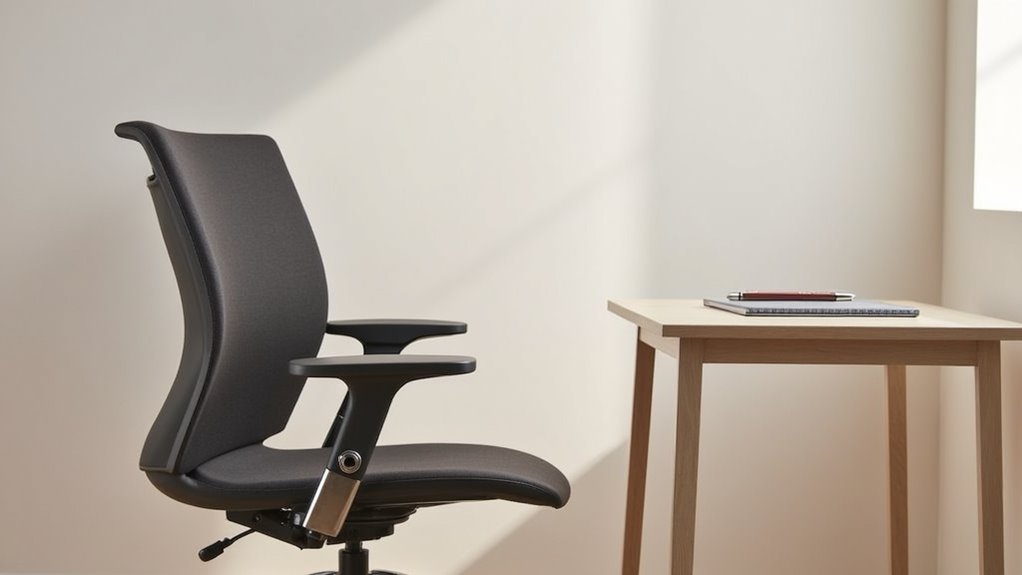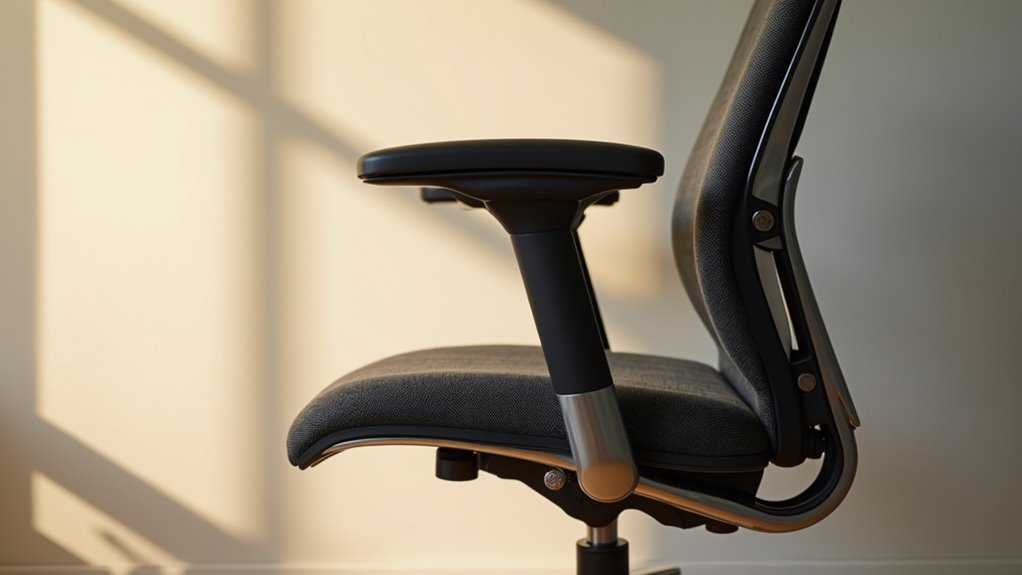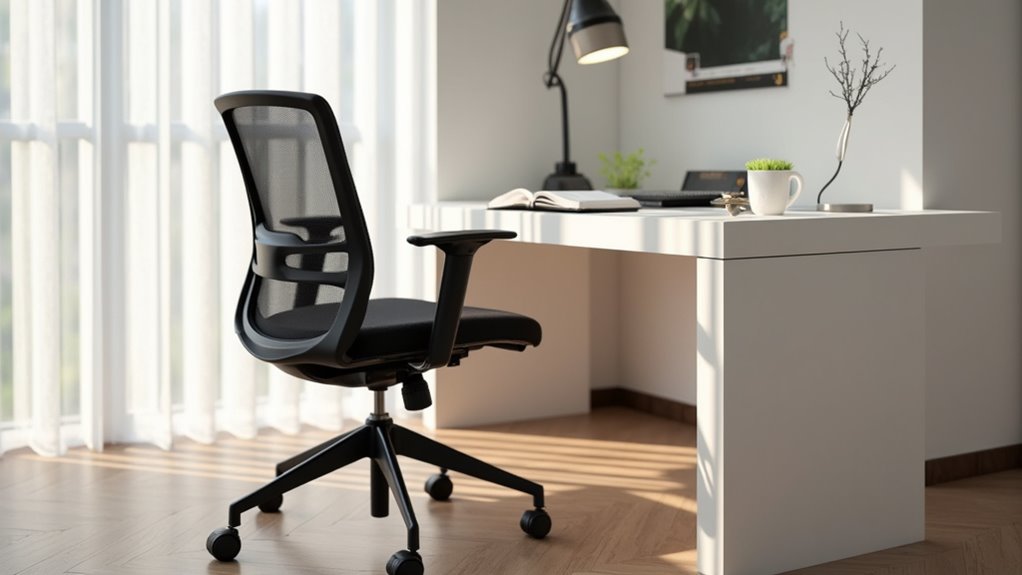How to Adjust the Office Chair
This post contains affiliate links. As an Amazon Associate, we earn from qualifying purchases.
To adjust your office chair properly, begin by setting the seat height so your elbows bend at a comfortable 90 degrees. Ensure there is a small gap behind your knees for optimal support. Next, adjust the backrest to support your lower back and position the armrests snugly to keep your shoulders relaxed. It’s also important that your feet are flat on the floor. Further tips and detailed explanations on achieving the perfect chair adjustment will follow for those looking to enhance their seating experience.
Essential Facts in 30 Seconds
- Adjust chair height for elbows at 90 degrees with relaxed shoulders.
- Maintain a 2-4 inch gap between seat edge and back of knees for proper seat depth.
- Position lumbar support at waist level to match lower back curvature.
- Align armrests to support elbows at 90 degrees, adjusting height and width to prevent shoulder strain.
- Set footrest for flat feet and knees at or below hip level for better support.
Seat Height Adjustment
Adjusting your office chair can greatly improve your comfort and focus.
Start by finding the lever under the seat. Pull it up while sitting to raise the chair. To lower it, sit back down and let your weight press down. Aim for your thighs to be parallel to the floor. Keep your feet flat on the ground or on a footrest. A proper chair height adjustment ensures that your knees remain at a 90-degree angle, further enhancing your ergonomic setup. Proper height also enhances posture which is crucial during long hours of sitting. Additionally, proper height adjustment significantly impacts overall comfort and helps prevent discomfort and poor circulation. A well-adjusted chair can also reduce strain on your back, neck, and shoulders during prolonged use.
For chairs with a screw mechanism, use a wrench or screwdriver. Turn it until you reach the right height. Proper height helps with good posture. It also reduces strain on your knees and back.
A well-adjusted chair can make a big difference in your workday. Stay comfortable and productive!
Seat Depth Adjustment

You’ve got your seat height just right. Now, let’s adjust the seat depth! This step is crucial for your comfort. A good seat depth keeps your legs relaxed. It helps avoid that uncomfortable feeling when sitting too deep or too shallow.
Aim for a small gap between the seat edge and the back of your knees. This gap is important. It gives your legs support without cutting off circulation. A well-adjusted seat depth maintains good posture and aids blood circulation, making it feel like a warm hug for your legs. Additionally, ensuring the proper seat depth can help reduce discomfort and fatigue during long hours of desk work. This adjustment contributes to overall ergonomic support and helps prevent strain on muscles and joints.
Take a moment to find that sweet spot. Small changes can make a big difference. Enjoy your comfy workspace!
Ideal Seat Depth
Finding the ideal seat depth for your office chair is important for comfort and support. The right seat depth helps you sit properly and feel good. Here are some tips for the perfect fit:
- Sit all the way back against the backrest.
- Leave a 2-4 inch gap between the seat edge and your knees.
- Keep your knees at a 90-degree angle or a little more.
- Make sure your feet rest flat on the floor. Proper height is crucial for maintaining comfort throughout the day. Adjusting the chair height ensures that your legs feel relaxed yet supported.
Getting it right helps keep your spine aligned and reduces pressure on your thighs. Proper posture is essential to prevent slouching and discomfort while sitting for extended periods. Additionally, this adjustment can enhance thigh support for improved circulation.
Adjust your seat depth to say goodbye to discomfort. Your back will appreciate it!
Adjustment Mechanism Explained
Adjusting the seat depth of your office chair greatly improves comfort and productivity. A sliding seat mechanism allows you to pull a lever and slide the seat forward or backward.
Find the perfect spot for your body! Proper chair height is also crucial when adjusting the seat depth to ensure your feet remain flat on the floor. Maintaining the chair components, like the gas lift cylinder, is vital to prevent issues such as sinking.
An adjustable backrest also helps change the seat depth. Keep your feet flat on the floor. Aim for a gap of about 2-3 fingers behind your knees. Proper lumbar support is essential for maintaining comfort during long hours of work.
Regular adjustments are important. This is especially true if you’re taller or shorter than average.
Try it out and soon you’ll sit comfortably in your ergonomic chair!
Benefits of Proper Depth
Finding the right seat depth in your office chair makes a big difference in comfort and focus. A properly adjusted seat depth helps circulation and supports good posture. Here’s why it matters:
- It prevents pressure behind your knees, which improves blood flow.
- It keeps your spine aligned, reducing back strain. Proper back support is essential for maintaining this alignment. Additionally, good posture can enhance physical well-being, making it vital to adjust your chair correctly.
- It distributes your weight evenly, which cuts down on discomfort.
- It boosts overall comfort, making you more productive.
A chair that fits well helps you feel more energized. You can avoid aches and pains from sitting too long. Correct sitting posture maintains good health and prevents discomfort.
Take a moment to adjust your chair. Your body will appreciate it!
Backrest Adjustment

Getting your backrest right can change how comfy you feel while working or studying. Check if your chair has adjustable lumbar support. This support should fit the natural curve of your lower back. Position it around your waist level. It should hug your back when you sit up straight—like a cozy hug!
For chairs with a ratchet backrest, pull it up one click at a time. Find that sweet spot where you feel good. Adjust the firmness too! You want it just right—not too hard or too soft.
Make sure the backrest height supports your entire back. It shouldn’t push you into an awkward position.
With these simple tweaks, you’ll sit comfortably and avoid back pain. Enjoy your productive vibes! Adjust your chair like a pro!
Armrest Adjustment

Adjust those armrests for comfort!
Keep your elbows bent at a 90-degree angle. Your forearms should be parallel to the floor. This position helps relax your shoulders.
Make sure the armrests match the height of your desk. This way, you can type easily without stretching too much. No one wants to feel like a pretzel at work!
Proper armrest height supports good posture and reduces strain. Enjoy a more comfortable workspace!
Ideal Armrest Height
Finding the right armrest height for your office chair can greatly improve comfort. Aim for armrests that are 7 to 10 inches above the seat.
They should match the height of your desk when your elbows bend at a 90-degree angle.
Make sure your shoulders stay relaxed. Your arms should feel well-supported.
Try different heights to see what feels best for you. A little adjustment can make a big difference in comfort while you work.
Correct Elbow Positioning
Finding the right elbow position can make your workday more comfortable. Adjust your armrests so they just touch the undersides of your elbows. Keep your elbows bent at about a 90-degree angle. This support helps relax your shoulders and reduces strain. Elbows should stay close to your sides. Avoid the awkward chicken-wing look! Additionally, having the right ergonomic chair can greatly enhance your overall posture. Proper chair selection is essential for maintaining comfort and balance throughout your workday.
If your armrests are too high, consider removing them. Your elbows should line up with the keyboard. No reaching or rounding those shoulders!
Keep adjusting the height until you find the best spot. A good setup will help you work like a champ! Additionally, proper chair adjustments can significantly enhance your overall comfort while working.
Armrest Alignment With Desk
Getting your armrests right is key for comfort at your desk. Adjust the height so they touch your elbows when bent at 90 degrees.
Check how far apart the armrests are. They should be wide enough to avoid shoulder strain but not too narrow to feel cramped.
Adjust the depth by sliding them forward for close tasks or backward for a relaxed position. Use the pivot feature, if available, to find the best angle for your work.
- Adjust height for elbow comfort.
- Set proper armrest spacing.
- Slide for correct depth.
- Use pivot for flexibility.
Chair Tilt and Recline

Adjust your office chair for the best comfort. Start by checking the tilt mechanism. Some chairs tilt the backrest and seat together. Others let you adjust them separately. A synchronous tilt gives better support for long hours.
Find the lever or knob under your seat. This is your tool for comfort! Adjust the spring tension to fit your weight. It should feel just right. A properly functioning height adjustment mechanism ensures that you can customize your sitting position effectively.
Want to relax? Lock your chair at a comfy recline angle. This is great for taking breaks. A proper tilt reduces pressure on your thighs. It also helps blood flow. Regularly check the chair’s wheels for smooth rolling to ensure optimal performance and comfort.
Remember to move around. Adjust your chair often to keep things fresh. With these tips, you’ll sit comfortably and enjoy your time at work. Enjoy taking charge of your comfort!
Footrest and Workspace Integration

Comfort isn’t just about your chair. It includes your feet and workspace too! A footrest is like a cozy hug for your legs. A well-designed footrest can really improve your workspace comfort.
Here’s how to set it up:
- Set your chair to the right height. Your elbows should be level with your desk.
- Adjust the footrest so your feet lie flat. Your knees should be at or below hip level.
- Ensure there’s enough space under the desk. Your feet need room to move freely.
- Make small adjustments often. This keeps your workspace comfortable.
With these tips, your workspace will feel better. Enjoy the comfort!
Frequently Asked Questions
How Often Should I Adjust My Office Chair Settings?
Adjust your office chair settings every day. Follow ergonomic guidelines for the best results. Reassess your chair when you feel discomfort or tiredness. Regular adjustments keep you comfortable and supported. Good posture matters for your work. Make sure your chair fits your needs. A well-adjusted chair can reduce back pain and improve focus. Stay aware of how your body feels throughout the day. Prioritize your comfort for better productivity.
Can I Use a Cushion With My Office Chair?
Using a cushion with your office chair is a great idea. Cushions make sitting more comfortable. They help relieve pressure on your back and legs. This support can lead to better posture, which reduces back pain. Staying comfortable while you work can help you focus and be more productive. Many people find that a cushion makes long hours at a desk much easier. A good cushion can really change your work experience for the better.
What Type of Chair Is Best for Long Hours?
Not all chairs are created equal. For long hours, select a chair with ergonomic features. Look for good lumbar support. This support helps keep your back comfortable. A well-designed chair can reduce tiredness. It boosts your focus and productivity.
Consider adjustable height and armrests. These features allow you to find the best fit. A soft seat cushion adds comfort, too. Breathable fabric keeps you cool during long sitting. Your chair should promote good posture. Good posture helps prevent pain and strain.
Investing in a quality chair is smart. It pays off in comfort and health. A great chair can change how you feel at work. So, choose wisely for your long hours.
How Do I Maintain My Office Chair’s Mechanisms?
To keep your office chair in good shape, check its mechanisms often. Look for dirt and dust. Clean them with a soft cloth. Use oil or lubricant on moving parts to keep them working smoothly. Tighten any loose screws to prevent wobbling. If parts wear out, replace them quickly. These steps help your chair last longer and work better. A well-maintained chair makes sitting more comfortable. Take these simple actions to enjoy your chair for years.
Are There Specific Chairs for Different Body Types?
Imagine sitting on a throne made just for you. Chairs designed for different body types can change your comfort levels. Ergonomic features help support your body. This support promotes better health and comfort. The right chair can make a big difference in your workspace.
Chairs come in various sizes and shapes. Some fit larger frames, while others are perfect for smaller bodies. Different heights also play a role. A chair should match your height for the best support.
Adjustable features are important too. Armrests, seat height, and lumbar support should be easy to change. This allows you to find the perfect fit.
Sitting in the wrong chair can lead to pain. Backaches and neck strain are common issues. A well-fitted chair helps prevent these problems.
Investing in the right chair is worth it. Better comfort leads to better focus. This can boost your productivity at work. Choose wisely for a happier, healthier sitting experience.
Conclusion
Adjusting your office chair is important for comfort and focus. A well-adjusted chair can help prevent back pain and make long work hours easier. Start by setting the seat height. Your feet should rest flat on the floor. Next, adjust the backrest. It should support your lower back.
Check the armrests too. They should be at a height where your shoulders can relax. Finally, make sure the chair reclines slightly. This helps reduce pressure on your spine.
Testing these adjustments is key. Small changes can lead to big comfort improvements. Enjoy your time sitting at your desk! And remember, quick clean-up tricks work well for spills. Happy working!
